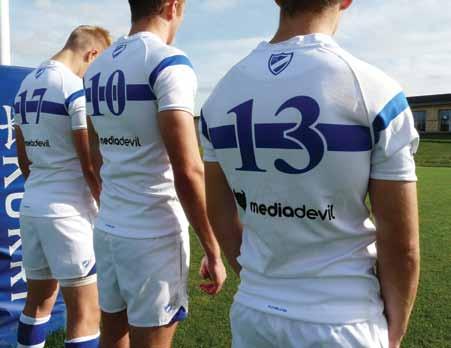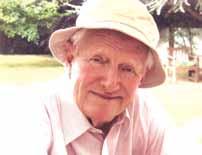
24 minute read
Obituaries & Memoriam
obitua ries
We are pleased to include brief obituaries of deceased OUs though due to the limitations of space we need to edit submissions. Unabridged obituaries are available to view on the OU website.
Advertisement
Frank South (Fgh 29) By Derek Bunting (B 45)
Frank South was born in Salisbury in Southern Rhodesia in 1915. At the age of 13 he made the six weeks’ journey to Uppingham. Cricket was his great sport. He was in the Uppingham XI in 1934 and went on to Cambridge where he played for Pembroke. He obtained a BA Chem before going on to join S H Johnson and Co Ltd, Chemical Engineers, where he rose up to be MD and later Chairman. He married Esther in 1941 and they had 4 children. Carol, Barry (Fgh 59), Nicky and Andrew (Fgh 69). Frank and Esther were married for 72 years. His first love was cricket and he joined the Rovers in 1939, and attended their 125th anniversary dinner held in October 1988. In later life he became a very keen golfer and supporter of the Old Uppinghamian Golfing Society, holding his captain’s meeting at Royal St George’s, Sandwich in 1990. He was elected President for 1998 and 1999.
Peter Llewellin Lindrea (F 30) By his son Martyn (F 54) Peter Lindrea died on October 3rd 2012 after a stroke. He was born in Portishead in 1917 and went to prep school in Weston-Super-Mare before Uppingham. In 1938 he joined the Green Howards Regiment as a territorial and was commissioned as a 2nd lieutenant. He spent 2 ½ years in the Western Desert and was at Dunkirk. When moving into France with his platoon, they came across an empty house with a cellar full of Champagne. Not only did they enjoy drinking it but it was almost certainly the only time they ever shaved in Champagne! He reached the rank of Major, winning the Territorial Decoration and being cited for a Military Cross. After the war he joined the family business of Lindrea and Co as head of the leather side of the firm. His great knowledge of the leather industry was much respected and together with his undoubted charm, brought business from many of the leading shoe and clothing manufacturers. In 1949 he moved to Somerset so that he could run the company’s head office in Bristol. But this was all to end in 1971 when the company’s owners decided to liquidate their interests and he moved on and had 11 happy years with BB Vos before retiring in 1983. He sent his sons to Uppingham, Martyn (F 54) and Nigel (F 57) and gave them great support in all the sporting and music activities in which they were involved. In 1971, he converted an old barn into a lovely country home and enjoyed life in deepest Somerset for almost 40 years, watching his favourite county playing cricket. He leaves behind his wife of nearly 73 years Mary, his two sons and a daughter, grandchildren and great grandchildren.
Bryan Jenks (SH 32)
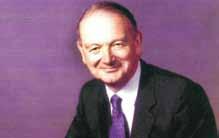
Royal Ascot and Bryan was champion National Hunt owner in the 1968/69 season. He was elected to the Jockey Club in 1970. In 1988, at the age of 70 he retired to Monaco.
Anthony Howitt (C 33) Anthony Howitt was a leading accountant who promoted the role of computers during the early years of data processing and played a prominent role in laying the foundations of the management consulting profession. On leaving Uppingham in 1938 he studied at Trinity College, Cambridge before serving in the Royal Regiment of Artillery during WWII. Tony joined Peat Marwick Mitchell (now KPMG) in 1946 and will be particularly remembered for his pioneering work as a Chartered Management Accountant. In 1957 he led the way for Chartered Accountants to play a key consulting role alongside their auditing and accounting functions, so laying the foundations for the new Management Consulting profession. Tony was elected President of the CIMA Council in 1972 and he founded the CIMA Anthony Howitt Lecture in 1985. Tony was the son of Sir Harold Howitt (WD 1906), a former Chairman of Trustees at Uppingham and he remained a loyal OU throughout his life. During his long career with Peat Marwick (until 1984), Tony was also elected Master of the Merchant Taylors’ Livery Company in 1980. Tony died in September 2013 and is survived by June, his wife of 61 years.
Bryan Jenks, former Shropshire business tycoon, farmer and successful racehorse owner, died in May 2013 aged 94 after a long illness. Born in 1918, brought up near Wolverhampton, he started work in the family’s brass tap company in 1937. His business career was interrupted by wartime service in the Army which saw him evacuated from Dunkirk with pneumonia, but in the post-war period he and his father built the company into a major force. One of Bryan’s biggest joys was horseracing, which saw him owning horses on the flat with some of the biggest names in the turf, including Robert Sangster. His horses had success at Cheltenham and
Guy Street (LH 33) By Guy’s niece, Caroline A Campbell Guy Street died on 6th March 2013 at the age of 93. After Cambridge he joined the Malayan Police and when the Japanese invaded in 1942 he was sent to Singapore. In February 1942 the Japanese crossed onto Singapore. All evacuation vessels had long since departed. The Japanese were progressing rapidly south across the island when Guy and a small group of fellow officers secured a tiny sailboat in which they began the attempt to cross the Malaccan Straits. They were among the very last if not the last to leave the island and avoid capture.
obitua ries
Fortunately they were picked up by an escaping launch which got them clear of land before they were able to clamber aboard an escaping tugboat which landed them on the Sumatra Coast. They eventually reached Padang where they found an overcrowded ferry which sailed over 2000 km across the Indian Ocean to Ceylon. During their crossing they were torpedoed (the torpedoes passing beneath the ferry). Back in London, it became clear the attacking submarine had been one of our own! After the war he married his pre-war sweetheart, Jo Dane, and eventually returned to the UK to take up the old family business as a Marine Underwriter for Lloyd’s. In fact, Guy and his late brother, Hugh, were the last members of a family that had an unbroken involvement with Lloyd’s lasting over 180 years.
Dr John Maling (B 34)

from a reconnaissance unit arrived and said: “The bleeders are coming.” Eighteen German tanks followed by lorry loads of infantry rumbled down the road unaware of the presence of Maling’s platoon, or indeed of Allied anti-tank gunners in support. The gunners opened fire at point-blank range, disabling half the tanks, and three lorry loads of infantry stopped 50 yards from Maling’s position. Maling, who had held his fire until the leading tanks had driven over his slit trenches, then gave the order to shoot. His platoon killed 40 to 50 of the enemy (who turned out to be elite German paratroops) for the loss of only one man. As it got dark, Maling realised that he had to move, but he did not dare go back to the battalion, fearing that they would be so jumpy that they would shoot him and his men in the belief that they were Germans. He therefore led his men into enemy territory and carried out a big encircling movement, getting back to his lines at dawn. When Maling reported to HQ, officers were amazed to see him with his platoon intact. His colonel was convinced that they had all been captured. Maling was awarded an MC, following in the footsteps of his father, George Maling (WB 1903) who was awarded a VC in 1915. John married Judy in 1952 who survives him with a son and a daughter.
Dr John Maling, who died in December 2012 aged 92, won an MC in North Africa in 1942 and after the war practised as a GP in Kent. In November 1942, Maling landed at Bougie, Algeria, with the 6th Battalion the Queen’s Own Royal West Kent Regiment (6 QORWKR). In the dash for Tunis, the battalion was among the leading troops. The Germans reacted quickly and within a week had a strong infantry force supported by tanks in and around Tunis, as well as complete air superiority. On November 17, after a 20-mile march during which they were continuously strafed by bombers, the battalion arrived at the village of Djebel Abiod. Maling’s platoon had orders to defend an important road junction at all costs. They knew that their lives depended on the speed at which they could dig in and camouflage their slit trenches. That afternoon, a motorcyclist
Edward Ian Stanford (Hf 35) By his grandson Edward Daniels Ian was in his last year at Uppingham when World War II broke out and after completing his final term he joined the Local Defence Volunteers in Kent. One night whilst on sentry, a few miles from Biggin Hill RAF station, Ian was manning the post when a car approached; Ian challenged the driver who very abruptly told Ian to stand aside and let the Prime Minister through. Ian persisted and requested identification and once satisfied, heard Churchill’s gruff voice boom from the back of the car, “Well done my boy”. Ian joined the Scinde Horse and was posted to India in March 1941. After the war ended, Ian continued to serve and transferred into the Carabineers, later the Royal Scots Dragoon Guards. Ian was told of a story of the Seven Years War (1756-63) in which the Dragoon Guards served when a hard winter in 1760/61 had caused many men and horses to die of cold and starvation. The quartermaster of the 3rd Dragoon Guards, the predecessor of Ian’s regiment, signed for an invoice for forage from a farmer but never paid the bill. Ian was not a man to leave loose ends, and so two hundred years later he went to the same farm in Germany and met Herr Blume, a direct descendant of the farmer and said, “I hope that you will accept this picture and gold sovereign as full and final settlement of the Regiment’s debt of some two hundred years ago”. On his retirement Ian and his wife Jean moved to Chedington where he could pursue his other loves, hunting and farming. Ian passed away in January 2013.
Frank Latham (H 37) Born in 1924 in Spital, Frank attended Mostyn House prep school in the Wirral, and Uppingham. During World War II he wasted no time in signing up to the Home Guard. He joined the Gordon Highlanders in 1942 and three years later, he answered a call for volunteers in the Far East which heralded the onset of a two-year spell in India. In 1947, Frank entered the timber trade, eventually forming F Kearney and Latham in 1960, before retiring in 1991. He was awarded an MBE for services to heritage in 2004 and wrote 22 books to ensure the colourful past of a range of Cheshire villages was preserved forever. Frank was a long-standing chairman of his Parish Council and a former chairman of the Grosvenor Club. He had lived in Alpraham since 1965, with wife of 62 years Ann, before Alzheimer’s saw him move to a residential home in 2009 where he died. Frank leaves a son Michael (H 66), and two grandchildren.
Dr Kenneth Hugh-Jones (WB 37) Dr Kenneth Hugh-Jones, fondly known by colleagues as “H-J”, was a leading paediatrician and pioneer of bone marrow transplants. Appointed lead consultant paediatrician of the Bone Marrow Transplant Team at the Westminster Children’s Hospital in 1970, he oversaw the first successful bone marrow transplant for immunodeficiency disease in the UK and shortly afterwards the world’s first unrelated bone marrow transplant for chronic granulomatous disease, a rare immune deficiency state. who visited the island for a holiday. He is survived by his wife, Joyce and by his son, Antony, grandsons, Jim (M 95) and Chris (M 97), and great-grandson, Finn.
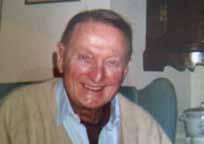
Brian Woodcock (F 38) By his son James Woodcock (F 84)
Stewart Green (WB 38) By his son Nigel Green (WB 66) Stewart Green left Uppingham around the outbreak of WWII and attended St. John’s College, Cambridge. He then joined the Indian army in 1942. On return to civilian life he qualified as a solicitor, having his own practice in Winchester. He was a city councillor, alderman and finally mayor of the city. On retirement he moved to Poole where he passed away.
Dennis Hurden (L 38) Provided by grandson Chris Hurden (M 97) Dennis left Uppingham in 1942, going on to New College, Oxford where he graduated with a degree in Engineering Science in 1944. He met his first wife, Marjorie, while they were both at Oxford; they were married in 1947. Dennis started work at Armstrong Siddeley Motors in their rocket motors development team. He became a key person in the UK rocket industry and in 1947 he was elected a Fellow of the British Interplanetary Society and subsequently met both Yuri Gagarin and Valentina Tereshkova (first male and female Russian astronauts). In 1968 he was recruited by Bell Aerospace Company in Buffalo where he met his second wife, Beth. He worked on the fuel system for the lunar lander that successfully put Neil Armstrong on the moon. They moved to New Orleans where he was the propulsion specialist for large surface effect ships developed for the US Navy. In 1978, he retired to Sark where he became a member of the Chief Pleas (the island Parliament). While on Sark he also had dinner with Neil Armstrong Born in Lancashire, Brian went as the third of four brothers to join Fircroft at Uppingham. He was House Captain, a School Praeposter, Captain of games, Cricket XI, Rugby XV for two years, and Captain of Eton Fives. He missed his second year in the XI in order to go up early to St John’s College, Cambridge in 1943 to read law. With WWII developing in intensity he left Cambridge and joined the RAF. After the war he returned to Cambridge to continue his studies. His Eton Fives was played at a very high level, and in illustrious company, winning three half blues partnering subsequent winners of the national championships. He also played rugby and cricket for the university and managed to fit in some studies, leaving with his LLB. Brian joined the family firm of solicitors, Woodcock and Sons - one of the oldest practices in direct descent in the country, happily serving as an articled clerk to his father. He married Alison in 1967, living in the Ribble Valley until retirement to Jersey in 1988 after nearly 40 years as a solicitor. Away from the office he played a great deal of cricket all over the country for a wide variety of clubs including the MCC and his beloved Uppingham Rovers. He died peacefully at home.
Neil Dallas (WD 39) By Peter Jackson (SH 40) In your last excellent magazine, you had an obituary for Colin Dallas and this prompted me to send a few words about his distinguished doctor uncle, Neil Dallas, who died just a few weeks before Colin in April 2012.
After Uppingham Neil read medicine at Trinity Hall, Cambridge, and followed this with periods at St Thomas’s and then Moorfields Hospital in London. There he was actively involved with the pioneering development of a lens implant in the field of eye surgery and he became a FRCS and an FRCOpth He then became Consultant Ophthalmologist at Bristol Eye Hospital and Frenchay and Lecturer at Bristol University where he continued until retirement. I first met Neil when we were both determined to play tennis while at school and, after we left, we jointly founded the OU Lawn Tennis and Squash Club for which he was a regular in the first pair at tennis and I usually played No. 1 in the squash team. For a number of years the Club was active and quite successful in the D’Abernon Cup old boys’ competition. We were each other’s respective Best Men many years ago and we enjoyed a special friendship ever since which continues today with his wife, Gillian and their two boys.
Justin Howse (F 42)
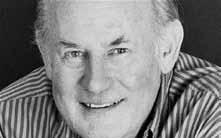
Justin Howse, who died December 2013 aged 83, was the foremost orthopaedic surgeon to the dance world. He used his pioneering approach with equal success to treat the injuries of sportspeople and musicians. Justin Howse was able to restrain his patients from premature returns to the stage. A recovering Judi Dench, for example, pulled out of the starring role in the 1981 production of Andrew Lloyd Webber’s Cats on his advice. He also refused to perform a risky operation that Margot Fonteyn requested on an injury, saying he did not wish to be known as the surgeon who ended the ballerina’s career. Justin was attached to the Royal Army Medical Corps for his National Service. He moved into orthopaedics and in 1966 became consultant orthopaedic surgeon at the Central Middlesex and St Vincent’s Orthopaedic Hospital. He took what he called a carpenter’s interest in artificial
obitua ries
joints, and invented the Howse Hip, a new type of hip replacement incorporating plastics along with metal. In 1966 he became orthopaedic consultant to the Royal Ballet where he became convinced that dance injuries were largely the result of faulty technique and training. In his capacity as the Royal Ballet School’s orthopaedic consultant he also vetted the physical suitability of every child applying to enter the school and is said to be a model for the doctor shown in the film Billy Elliott. During the 1970s Howse’s caseload was influenced by the rise of West End musicals. As well as Fonteyn, he regularly treated other leading ballet stars such as Wayne Sleep and was the first name called upon by Cameron Mackintosh and Lloyd Webber productions to treat injured performers. He founded the International Association for Dance Medicine and Science and in 2010 he was awarded the Association’s Lifetime Service Award. While training at the Middlesex in 1953, Justin Howse married Sherley Fawkner, who survives him with their four children.
Martyn Noble (L 42) By his son Simon (L 73) Martyn attended Mostyn House prep school and then Uppingham where he excelled as a swimmer, winning the Ellis Cup and was a member of the 1st VIII shooting team. After Uppingham he went off to do national service and he served in the Royal Electrical and Mechanical Engineers. During national service he was lucky to have a small car which at one point was somehow manhandled into the officers’ mess to be driven around the dining room table. After completing national service he went on to Gonville and Caius College at Cambridge where he studied Engineering. Following Cambridge he joined the family textile mill in Blackburn, which at one point was the largest jacquard weaving plant in Europe weaving fabric for use on the likes of the Royal Yacht and the QE2. Eventually he retired and settled down to plenty of gardening. He died peacefully in his sleep and leaves behind his wife Judy, sons Simon (L 73), Charles and daughter Jane and six grandchildren.
Charles Longbottom (B 44)

Charles Longbottom who died aged 82, was an energetic Conservative MP for York from 1959 to 1966, then, after losing his seat, a major player in Britain’s merchant shipbuilding industry. Charles was selected for York and at the 1959 “never had it so good” election he took the seat with a 4,074 majority. In the Commons he campaigned for York to be awarded a university of its own. Within four years the University of York was founded. Early in 1961 Charles was one of four young European politicians invited by the Young Democrats of America to President Kennedy’s inauguration. Longbottom held his seat by 1,047 votes in 1964 against the swing that brought Labour to power. However, when Harold Wilson called a snap election in March 1966 he lost his seat to the Labour candidate. In 1961 Charles married Anita Trapani, stepdaughter of a Greek shipping magnate and a year after losing his seat, he went into industry as chairman of the shipyard Austin & Pickersgill. While Britain’s shipyards as a whole were losing market share fast, A&P was on the crest of a wave. Nationalised by Labour, the yard ran out of orders in 1988. Longbottom served on the general advisory committee of the BBC and the Community Relations Commission. He was appointed OBE in 2012. Charles Longbottom’s wife survives him with their two daughters.
Richard Thorp (Fgh 45) Actor Richard Thorp, Alan Turner on Emmerdale for more than 30 years, died at the age of 81. He had been the longest-serving cast member on the ITV soap, having made his first appearance in March 1982. Thorp’s character started out in the show as the hard-drinking, womanising and bullying manager of Home Farm. But he mellowed over the years, going on to be landlord of the Woolpack pub. Thorp’s breakthrough role in The Dam Busters came at the age of 23. The actor had auditioned for a smaller role but was given the part of Henry Maudslay because he looked like him. He went on to appear in The Barretts of Wimpole Street and There’s Always a Thursday before joining hit TV series Emergency Ward 10. Before joining Emmerdale, Thorp appeared in a number of TV shows including Crossroads and To the Manor Born.
John Johnston (H 48) John Johnston went to Uppingham in the footsteps of five previous generations of his family. Having qualified as an accountant, he opted for National Service and was commissioned into the Scots Guards, serving in Germany on the frontier opposite Soviet troops and finally on Guard duties in London. His work in the City started with the merchant banking firm of Dawnay Day, and later in senior positions with Jacob Rothschild and the Rothschild Investment Trust. In 1962 he married Penny Kidston followed by the arrival of their four children. On his retirement they returned to Helensburgh having inherited John’s uncle’s old family home of Rhu Arden, an architectural gem from Thomas Leiper. John became a director of Helensburgh Heritage Trust in 2001. At the Service of Celebration and Thanksgiving at St Michael and All Angels Church on 12th October 2012 the attendance of over 300, including a Guard of Honour from the Scots Guards, showed the depth of regard for John.
David Wainwright (M 49) By his wife Sarah J. Wainwright During our married life of over 48 years together, David often had occasion to reminisce about the positive impact Uppingham had on his life, not just in academic training, in music and in sports, but particularly in the area of character and moral values as exemplified by the friendly and devoted staff. Most of our married life has been spent in the United States, but together with my husband and children I remember being impressed when we were able to visit and enjoy a meal with David’s old housemaster, Mr Denis Oswald and his wife Dorothy. This visit game me a glimpse of the formative background from which my husband had so greatly profited. I know that David would have wished me to thank you for all the school and OU news you have sent him over the years.
Eric Willings (F 57) By his son Mark Willings My father spoke fondly of his memories of being at school at Uppingham. Upon leaving, he studied dentistry at Leeds University. On graduating, he worked in Leeds before returning to Wakefield to work with his own father in general dental practice. In 1976, my father married my mother Margaret and they had three sons – Mark, Neil and Ian. I have practised with my father since 1994 and Dad very much enjoyed his work and in fact, was still practising until October last year when he was diagnosed with lung cancer. Dad fought his illness with bravery and courage and he never gave up hope. Dad had a house in France and it was always his goal throughout treatment that he should return there with all his family. We managed to do this in May and he was well at this time. Dad died on June 21st. He had remained well until the end, even going out with friends earlier on the evening that he died. of his generation. His entire career was spent in the Imperial War Museum and for 37 years he served as Keeper of the Department of Documents. In that role he personally assembled what is globally recognised as one of the largest and most important collections of private papers, ranging from those of ordinary citizens to the most senior soldiers. It is difficult to find any books on the First or Second World Wars published in the past 40 years that do not list Suddaby’s name in their acknowledgements. Roderick Suddaby graduated in history at King’s College London and was awarded a scholarship to Queen’s University, Ontario. Rod joined the Imperial War Museum in 1970 and had a particular interest in material relating to Far East prisoners of war. It was the widely recognised as the best collection of personal records of prisoners and internees of the Japanese across the whole of the Far East, which became the focus of his work following his retirement in 2011. He encouraged former PoWs to believe that their stories were worthy of preservation in the national collection and did much to encourage research in this field. Rod was a long-standing member of the Institute for Historical Research and played an important role in both the Army Records Society and Navy Records Society. For many years he was the mainstay of the museum cricket team, which played keenly fought matches against other museums. In July he was due to celebrate 40 years of marriage to Jenny, who, with his two sons, survives him.
Simon Tate (H 61) By his wife Christine Simon studied architecture at NewcastleUpon-Tyne and moved to Cornwall in 1978 where he worked for the council heading the design of many state of the art schools, providing children in Cornwall a purpose-built environment for education. Simon was known for his dogged pursuit of excellence and attention to detail, and received many architectural awards. He led a contented life, enjoying cycling, art, poetry and philosophy. Simon died of prostate cancer in February 2011 and leaves behind his wife Christine and two sons, Andy and Tim.
John Rushton (C 63) John Rushton died on 22nd May 2013 having being diagnosed with cancer, for the second time, in the middle of 2012. It was typical of his nature that he commented to several correspondents that “my lifespan, like my height, is likely to be shorter than I hoped”. Born in Southport in 1950 he went to a local prep school before gaining entrance to Uppingham School. From there he won a place at Sidney Sussex College, Cambridge to read Law in 1969. Following Cambridge John Rushton took articles at the City firm of Freshfields before moving on to Rowe & Maw. He was to stay at Rowe & Maw (which became Mayer Brown International LLP) for the rest of his practising days. When he retired from Mayer Brown he was appointed UK Arbitration & ADR Consultant to the International Chamber of Commerce. John is survived by his wife Jenny and their children, Carolyn and Mark.
Peter Seely (SH 63) A Godson to Prince Philip, the 5th Baron Mottistone, Peter Seely, died in Kent on January 23, aged 63, following a long illness. Born in Malta, Lord Mottistone, was the son of Island resident, the late David Seely, 4th Baron Mottistone. It is from his father he succeeded to the peerage, on November 24, 2011. Throughout his childhood, Lord Mottistone was a frequent visitor to the Isle of Wight, a place that remained close to his heart throughout his life. Lord Mottistone went on to study for an actuarial degree at the University of Birmingham. Lord Mottistone’s career in the insurance and financial services industry, as a company director, was based in London, Scotland and Kent. Lord Mottistone married twice and is survived by two sons, three daughters and three grand-daughters.







